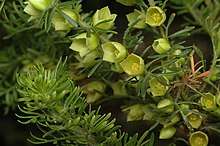Boronia tetrandra
Boronia tetrandra, commonly known as yellow boronia,[2] is a plant in the citrus family, Rutaceae and is endemic to Western Australia. It is a spreading or erect shrub with hairy stems, pinnate leaves and greenish cream to yellow or reddish brown, cup-shaped, four-petalled flowers.
| Yellow boronia | |
|---|---|
 | |
| Boronia tetrandra in the Australian National Botanic Gardens | |
| Scientific classification | |
| Kingdom: | Plantae |
| Clade: | Tracheophytes |
| Clade: | Angiosperms |
| Clade: | Eudicots |
| Clade: | Rosids |
| Order: | Sapindales |
| Family: | Rutaceae |
| Genus: | Boronia |
| Species: | B. tetrandra |
| Binomial name | |
| Boronia tetrandra | |
 | |
| Occurrence data from Australasian Virtual Herbarium | |
| Synonyms[1] | |
| |
Description
Boronia tetrandra is an erect or spreading shrub that grows to a height of 0.1–1 m (0.3–3 ft) or higher with branches covered with long, spreading hairs. The leaves are pinnate with between five and thirteen or more well-spaced leaflets. The leaflets are linear, about 12 mm (0.47 in) long. The flowers are greenish cream to yellow or reddish brown, cup-shaped and arranged singly in leaf axils on a short pedicel. The four sepals are broad, hairy and often coloured. The four petals are 7.5–10 mm (0.30–0.39 in) long and overlap for most of their length. The eight stamens alternate in length with those nearest the sepals thick with large anthers and those near the petals curving towards the style and with minute anthers. The stigma has four lobes. Flowering occurs from May to October.[2][3]
Taxonomy and naming
Boronia tetrandra was first formally described in 1805 by Jacques Labillardière[4] and the description was published in Novae Hollandiae Plantarum Specimen.[5] The specific epithet (tetrandra) is derived from the Ancient Greek words tetra meaning "four"[6] and aner meaning "male".[6]:509
Distribution and habitat
Yellow boronia grows on granite outcrops, coastal sand dunes and limestone cliffs in the Esperance Plains and Jarrah Forest biogeographic regions.[7]
Conservation
This boronia is classified as "not threatened" by the Western Australian Government Department of Parks and Wildlife.[7]
References
- "Boronia tetrandra". Australian Plant Census. Retrieved 18 February 2019.
- Paczkowska, Grazyna; Chapman, Alex R. (2000). The Western Australian Flora: A descriptive catalogue. Perth: Wildflower Society of Western Australia (Inc.). p. 521. ISBN 0646401009.
- Bentham, George; von Mueller, Ferdinand (1863). Flora Australiensis (Volume 1). London: Lovell Reeve and Co. p. 316. Retrieved 18 February 2019.
- Labillardière, Jacques (1805). Novae Hollandiae plantarum specimen. Paris. Retrieved 18 February 2019.
- "Boronia tetrandra". APNI. Retrieved 18 February 2019.
- Brown, Roland Wilbur (1956). The Composition of Scientific Words. Washington, D.C.: Smithsonian Institution Press.:351
- "Boronia tetrandra". FloraBase. Western Australian Government Department of Parks and Wildlife.